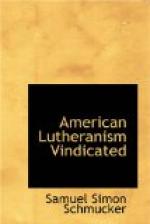ART. III.—On Baptism.
SECT. II. “By baptism as the laver of regeneration, and the renewing of the Holy Ghost, God saves us, and works in us such righteousness and purification from sins, that whosoever perseveres in such covenant, and reliance, will not be lost, but have eternal life.”
SECT. IV. “Baptism is the bath (laver) of regeneration, because in it we are regenerated, and sealed with the spirit of sonship and obtain pardon."-Mueller’s Symb. Buecher, pp. 848, 849.
That the doctrine of baptismal regeneration was taught by Luther, and the prominent older divines of our church, is well known to those acquainted with their works.
1. Luther, indeed, sometimes expressed the most extravagant ideas of baptism, maintaining that the water in baptism, was pervaded by the divine majesty, and was a (durch goettertes Wasser,) water penetrated through and through with God! [Note 1] He compares the water in baptism to heated iron, in which, though you see nought but iron, fire also is contained, which represents the divine name and power pervading the water. But we will not enter any further into his extravagant illustrations of the power of baptism. The result at which he arrives is thus expressed: “Therefore, he (this omnipotent name or power of God,) must also in baptism, make pure and holy, heavenly and divine persons, as we shall hereafter further see.” (Darum musz er auch in der Taufe reine und heilige und eitel himmlishe, goettliche Menschen machen, wie wir hernach sehen werden.”) [Note 2]
In his sermon on Baptism, Luther thus describes the influence of this ordinance:—“The import of baptism is a blessed dying unto sin, and resurrection in the grace of God, that the old man that was conceived in sin, may arise and go forth a new man born of grace. Thus St. Paul in, Tit. iii. 5, terms baptism a bath of the new birth, that in this bath men may be born again and renewed. Thus also Christ, in John iii. 3, says: Unless ye are born again of water and the Spirit (of grace), ye cannot enter into the kingdom of Heaven. For just as a child is born of its mother, and by this bodily birth is a sinful being and a child of wrath; thus also is man taken and born spiritually from the baptism, and by this birth he is a child of grace and a justified person. Thus are sins drowned in baptism, and thus does righteousness arise in the place of sin.” [Note 3]
2. Melancthon, whilst he by no means indulges in the extravagant and unscriptural views of a change in the water employed in baptism, by the Deity’s pervading it, &c., seems however in substance to have entertained views of the efficacy of this ordinance, amounting to baptismal regeneration.




